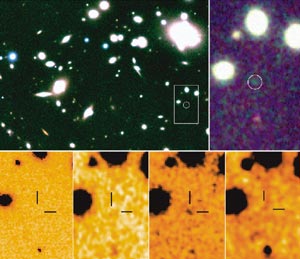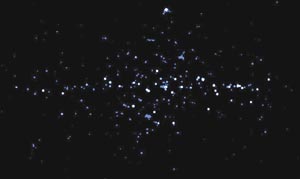
The discovery of a galaxy at a redshift of 10.0 smashes the record for the most distant object known in the universe. The detection of this very faint galaxy was made possible by combining the amplification effect of strong gravitational lensing with the power of the 8.2 m Very Large Telescope (VLT) of the European Southern Observatory (ESO).
The quest for the most distant object in the universe has made great progress during the past decade. The advent of telescopes with apertures of 8-10 m has allowed the detection of galaxies and quasars up to a redshift of 6.6. This corresponds roughly with the limit of what can be achieved in the visible domain. To detect higher redshift galaxies, near-infrared instruments are needed because the intergalactic medium almost completely absorbs the visible flux at shorter wavelengths than the Lyman α line, which is redshifted from the ultraviolet (121.6 nm) into the near infrared.
Using the ISAAC near-infrared instrument on the VLT in Chile, a team of French and Swiss astronomers has now been able to obtain strong evidence for the detection of a galaxy at a redshift of 10.0. This galaxy, named Abell 1835 IR1916, emitted the observed light 13.23 billion years ago. This was at a time when distances in the universe were 11 times smaller than now and the universe was merely 470 million years young.
This major breakthrough was made possible through light amplification by a factor of 25-100, resulting from strong gravitational lensing of the remote galaxy. This effect results from the bending of light by the huge mass of a galaxy cluster located along the line of sight to the distant galaxy. This natural amplification corresponds to an effective increase of the VLT aperture from 8.2 to 40-80 m.
From the images of the galaxy obtained at various wavelengths, the astronomers have deduced that it is undergoing a period of intense star formation. The total mass of stars already formed in this young galaxy is of the order of 10 million solar masses. This is about 10,000 times smaller than the mass of our galaxy, the Milky Way, and is comparable to the mass of the heaviest globular clusters. As only a small fraction of the mass of a galaxy is in the form of stars, the total mass of Abell 1835 IR1916, including a non-baryonic dark halo, is estimated to be of the order of a billion solar masses. This is in accordance with current cosmological models, as it corresponds to the collapse at a redshift of 10 of slightly more than a 2σ primordial fluctuation.
These properties are strong indicators that Abell 1835 IR1916 is indeed one of the building blocks of the large galaxies seen today, thought to have been assembled through the merging of many smaller protogalaxies. These blocks are also thought to be the first light sources to lift the fog over the universe and put an end to the “dark ages” (CERN Courier October 2003 p13). The discovery opens the way to explore further this unknown territory at the boundary between the “dark ages” and the “cosmic renaissance”, both from the ground and with the James Webb Space Telescope due for launch in 2011.
Further reading
R Pelló et al. 2004 Astron. Astrophys. 416 L35.
Picture of the month

The analysis of this image of the central regions of the Milky Way as seen in gamma rays by the INTEGRAL satellite of the European Space Agency (ESA) solves the 30-year-old mystery of the diffuse gamma-ray emission of the galaxy. This was discovered by balloon-borne experiments in the mid-1970s, and attempts to explain it were in terms of emission processes within the interstellar gas. The high sensitivity and resolution of INTEGRAL have revealed that about 100 individual sources contribute to what appeared as a diffuse glow to previous observatories. At least some of the newly detected sources are likely to be obscured binary systems like IGR J16318-484 (CERN Courier Dec 2003 p15). (Lebrun et al. 2004 Nature 428 293. Credit: ESA, F Lebrun; CEA-Saclay.)







